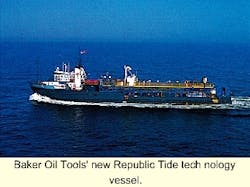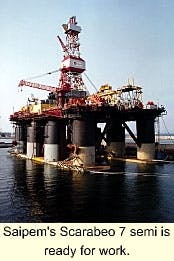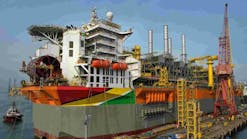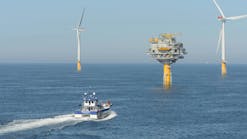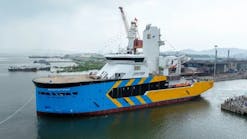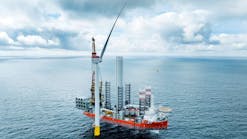Belfast's Harland & Wolff shipyard is facing tough times. The company's two major contracts are in turmoil. The first, and more pressing problem, is that the Borgland Dolphin semisubmersible, which has been converted at the shipyard for owner Fred Olsen, has not been accepted by operator Statoil. The rig was originally set for delivery in the third quarter of 1998 with a six-year contract to work for Statoil. The unit has been delayed and is over budget.
Beyond the delays and cost overruns, Statoil has said that construction on the rig has not been completed to its satisfaction, specifically "structural and safety considerations." While the dispute is not directly with Harland & Wolff, but rather with the shipyard's parent company, Olsen Energy, it could not have come at a worse time.
At the same time, Harland & Wolff is trying to solve a problem with a another major client - Global Marine. The builder informed Global Marine that it's two deepwater drillships, the C.R. Luigs and the Jack Ryan are going to be delayed to the first and third quarter of 2000, respectively, and are over budget. Global Marine has said that it will not pay for the additional costs which Harland & Wolff has assigned to Global Marine. However, the companies are in discussions, and are, according to a joint statement by the two parties, working together to determine completion costs for the drillships and the amount of funding needed to complete construction in a timely manner. The companies also said that Global Marine has agreed to forward a $31 million stage payment to Harland & Wolff.
In August, Harland & Wolff secured a £50 million loan to provide working capital and warned that if something is not done soon to resolve the issue, it could be detrimental not only to the company, but to the whole Northern Irish economy. The company estimated that over 3,000 jobs are in jeopardy with this dispute.
Two new pumping technology vessels
Baker Oil Tools' new Republic Tide tech nology vessel.
Baker Oil Tools has launched the Republic Tide technology vessel, a new completion, workover, and stimulation services vessel. The Republic Tide is a dynamically positioned vessel, and measures 226 ft in length by 40 ft wide, with a cargo deck of 140 ft by 31 ft. The vessel has a 7,400-bbl fluid capacity and 5,750 hp main engines.
Republic Tide has full data monitoring capabilities including SMARTS (stimulation monitoring reservoir testing software) with remote data transmission capabilities, 30,000 lb capacity gravel infusers, 800,000 lb sand storage in four pneumatic delivery tanks, and 30,000 gallons of raw stimulation chemical capacity. The vessel also has 17,000 gallons of batch mixing capability for stimulation products, in addition to a high rate, "mix-on-the-fly" capability.
As far as pumping, the Republic Tide has 3,500 HP, situated on three independent remotely operated skids, for use in stimulation processes. The units can pump at a 20 bbl/min, with 8 bbl/min rate capability for continuous-mix acid applications. It has a 300-ft Coflexip reel with a hydraulic disconnect. The vessel is working in the Gulf of Mexico.
Baker also has a similar vessel - the R C Baker - under construction. The vessel measures 224 ft in length by 54 ft in width, with over 1,000 sq ft of cargo space. The R C Baker vessel will also be dynamically positioned and have a retractable 360° azimuthing bow thruster. In terms of pumping capabilities, the R C Baker will surpass the Republic Tide by having 8,000 pumping hp, as compared to 3,500 hp for the Republic Tide. The R C Baker also will have pumping capabilities of 60 bbl/min, and uses a Frac Blender with proppant delivery rates of 100-15,000 lb/min, 15 bbl/min total rate capability for continuous mix acid applications, and 50 bbl/min for the chemical additions system. In addition, the vessel will feature 200 ft of 3-in. Coflexip hose with hydraulic disconnect and 100 ft 3-in. Coflexip hose section to facilitate rigup.
The R C Baker will also feature 500 tons of sand storage in five pneumatic delivery tanks, 189,000 gallons of batch mixing capabilities, and computer controlled blender for accurate control of both water pack and frac pack proppant schedules.
Scarabeo 7 semi complete
Saipem's Scarabeo 7 semi is ready for work.
Saipem's Scarabeo 7 semi-submersible has been completed. Saipem recently christened the converted unit at the Fincantieri shipyard in Palmero, Italy, where the work was done. The project began in the Tuzla shipyard in Turkey in 1997, where the unit was converted to operate in 1,500 meters water depth and a total drilling depth of over 7,500 meters.
The Scarabeo 7 is a converted F&G Enhanced Pacesetter - GVA Conversion design. It features eight columns with a thruster-assisted eight line mooring system. The mobile rig measures 110 meters long, 61 meters wide, and 110 meters high, and has a variable deck load of 4,000 tons in drilling mode. In addition, the rig is rated zero pollution and zero discharge.
The Scarabeo 7 will work its first contract for Agip, which is expected to last about two and one-half years.
Friede Goldman Halter merger complete
The Friede Goldman International - Halter Marine Group merger is complete. The new combined company is now called Friede Goldman Halter, Inc. Under the terms of the merger agreement, Halter shareholders exchanged each Halter share for 0.57 of a share of Friede Goldman International common stock. As for overall changes, by year-end, the new company plans to close Friede's corporate offices in Jackson, Mississippi and combine management personnel at Halter's corporate headquarters in Gulfport, Mississippi. In addition, it will close TDI-Halter's Houston sales office and consolidate all marketing and development related to the offshore energy industry at Friede's office in Houston. From there, the company will evaluate the profitability and efficiency of all production facilities, identify facilities for sale, closure, or reallocation of use.
Ultra-deepwater pipelay ship now in contract
Coflexip Stena Offshore has signed a construction contract with Hyundai MIPO in South Korea for the construction of a newbuild ultra-deepwater pipelay and construction vessel. The vessel will cost $170 million and is scheduled to begin work in the second quarter of 2001.
The new vessel is based on the Gusto 10000 design and will be capable of subsea construction and laying rigid and flexible pipe and umbilicals down to 2,500 meters. The vessel will have a storage capacity of at least 8,000 tons of products, a heavy lift capability of 400 tons, and a transit speed of 13 knots.
The company had originally planned to upgrade one of its existing vessels, the CSO Kitt, but after reviewing the cost of the upgrade ($150 million), versus the $170 million newbuild, decided the newbuild plan was the optimal solution.

